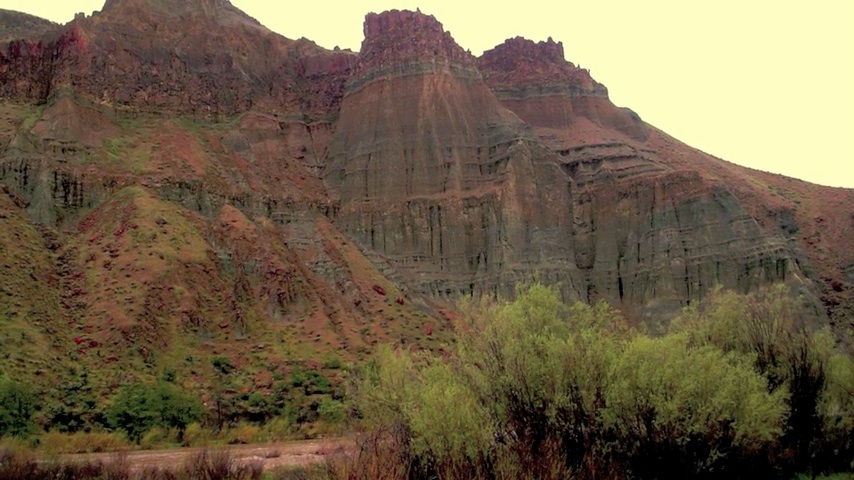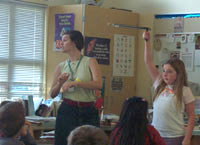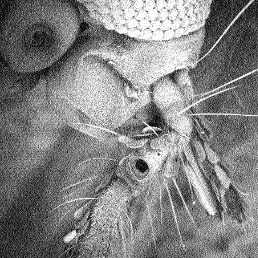
Current: School Slinky Seismomometer Teacher Professional Development
The Livelybrooks Gropu has led teacher professional development workshop, first via teleconference with teachers from the Thai Royal Distance Learning Foundation and affiliated schools, then in Coos Bay, Oregon. These workshop focus on the physics, engineering and mathematical constructs that underlie the development and operation of simple 'slinky seismometers' that can be deployed in schools, upload data to an international database, and can detect >= M6.5 earthquakes worldwide. These efforts, summarized here, have been supported by the Thai Distance Learning Organization (DLO) and the NSF EarthScope program.
Current: Tsunami Wave Tank School Experiments
The Livelybrooks Group has initiated and led the development of an 8' x 2.5' x 2.5' tsuanmi wave tank transportable to Lane County schools for student experiments. Built by John Boosinger of the UO Technical Science Administration, the tank is capable of supporting student engineering projects to build tsunami-proof scale model structures, but also can be used to explore various was of 'actuating' tsunamis that mimic the wide variation of tsunami-genesis found in nature. Here is a video of the 'alpha test' of the wave tank at Prairie Mountain Middle School in the Eugene Bethel School District.
Current: Lane County Content in Context (C^2) and Content in Context Super Lessons (C2SL) Math-Science Partnerships
Livelybrooks was one of the founding members of these U.S. Department of Education/Oregon Department of Education math science partnerships. They bring K-12 teachers and administrators, higher education faculty, and STEM government and industry partners together to develop student projects (note that this link has now transformed into that for the Lane County Regional STEM Hub) that model real-world applications of science, engineering and math. C^2 and C2SL teacher/partner teams develop and adopt curricula based on the pedagogy of projects-based learning (c.f., the Buck Institute Projects-Based Learning page) and that serve to support Common Core State Standards and the Next Generation Science Standards.
Current: National Science Foundation (NSF) Cascadia Initiative and 'CC@Sea' Program
The Cascadia Initiative is a community experiment that deploys ocean-bottom seismometers (OBS's) off the coasts of Vancouver Island, Washington, Oregon and N. California to help understand aspects of the Cascadia subduction zone. In 2011 community college (CC) students from Mt. Hood CC and Umpqua CC served on a cruise to deploy trawl-resistant mount (TRM) OBS's developed by the Lamont Doherty Earth Observatory under the direction chief scientists Maya Tolstoy and engineer Andrew Barclay. Additionally, the 'CC@sea-ers' helped co-chief scientst Anne Trehu (of Oregon State University) use the ship's echo-sounders to locate methane bubbles from seeps associated with the Cascadia trench.
Here is a (very compressed) link to
 a movie the CC@sea-ers made called 'Cruisin Cascadia'.
a movie the CC@sea-ers made called 'Cruisin Cascadia'.
Past: NSF GK-12:
For 11 years the UO MSI GK-12 program placed 8-13 chemistry and physics graduate students in Lane County, Bend-area and Hermiston/Pendleton-area K-8 schools, co-teaching with regular teachers, providing 'classroom-embedded professional development' and generally supporting use of state-of-the-art 'science kit' curricula. Our program focused on the physical sciences, and we pioneered a 'remote model' where students travelled to central and eastern Oregon and spent 2 weeks per term staying in the local community and working with a particular school. We partnered with Oregon Education Service Districts (ESDs) along with individual schools and school districts in this effort. Profs. Dave Johnson and Cathy Page of UO Chemistry and Prof. Raghu Parthasarathy of UO Physics were co-PIs, and Anae Rosenberg, then Christine Butler were our very able program directors. Here are some pertinent links:
GK-12 home page
Past: NSF eMAST:
The second is project eMAST, excellence in Math And Science Teaching, funded by NSF's Teaching Practices Continuum program and ably led by Prof. Jill Baxter of the UO College of Education. This program seeks to develop models for professional development that enable K-5 teachers to teach mathematics content (e.g., data analysis, 'algebra') within the context of science instruction using hands-on curricula such as 'science kits.'
Past: NSF UCORE:
The third project-- UCORE (Undergraduate Catalytic Outreach and Research Experience)-- just started in 2007. This NSF STEP-funded program brings end-of-first-year students from six partner Oregon community colleges to UO and other Oregon University System research labs for a summer 'research camp,' an authentic research experience in Chemistry, Geological Sciences or Physics and a training workshop. Students are trained at the end-of-summer workshop to be 'catalytic' back at their home institutions.... they will lead tutorials and research/career seminars to increase interest in degrees and careers in the physical sciences. (the UCORE team comprises Livelybrooks, Hulpke, Rosenberg and Johnson).
Past: U.S. Dept. of Energy TTSEM:
Another project funded by the U.S. Department of Energy through ONAMI has brought an FEI table-top scanning electron microscope (TTSEM) to the UO. This portable back-scatter electron microscope is capable of imaging to about 10,000 X, and is being used by local high school and middle school teachers to improve student understanding in biology, chemistry, physics and the earth sciences. The TTSEM team also includes physics grad. student Ben Lopez, 'TTSEM Fellow.'
Here are some PDFs of application (sample) notes and other information about our TTSEM outreach program:
Past: NSF OCEPT:
Project OCEPT (Oregon Collaborative for Excellence in the Preparation of (science and math) Teachers) was where I got my start. It was an NSF-funded state-wide program that brought together CC, 4-year and research university science and math instructors to foster excellence in college teaching. It was a delightful and enlightening experience!







